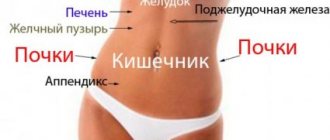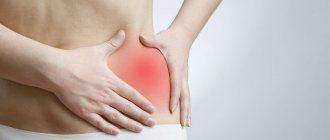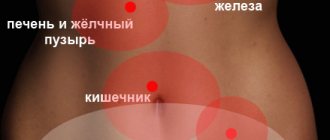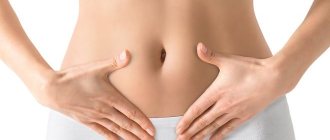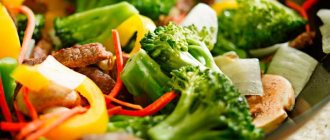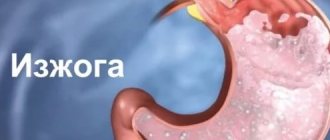Pain in the left side under the ribs is a serious syndrome that should not be ignored under any circumstances. Pain is a normal reaction of the body to injury, physical stress, sudden movements, physiological changes, for example, during pregnancy. But, besides this, they can talk about more serious hidden phenomena that occur in the body. Pain syndrome can be associated with an inflammatory process or with pathologies of internal organs and systems. When identifying the main cause that caused painful spasms, it is important to take into account their nature, duration and exact location. If pain occurs, an examination of the body is necessary.
Pain in the left side should never be ignored
Organs of the left hypochondrium
The left hypochondrium is the area located under the two lower ribs on the left side of the conditional middle of the abdomen. The following organs are located here:
- spleen;
- pancreas;
- left side of the stomach;
- aperture (left side);
- small intestine;
- colon;
- the left kidney and its ureter, as well as ligaments.
In addition, there are some other types of pain in this area that are not directly related to the above organs. They are a consequence of diseases of the internal organs in other areas of the abdomen or parts of the body and spread along nerve fibers (see below).
Causes of pain in the left hypochondrium
The main causes of pain in the left hypochondrium are as follows:
- stomach diseases, most often ulcers, gastritis;
- pancreatic diseases - pancreatitis;
- spleen diseases;
- pathology of the left kidney;
- diseases of the small and large intestines.
Also, no less rarely, pain in this area can be caused by:
- inflammatory processes of the diaphragm, its hernias and tumors;
- pneumonia of the left lung;
- heart diseases, in particular angina pectoris, heart attack, coronary artery disease;
- osteochondrosis of the lumbar and thoracic spine;
- inflammatory processes in the left appendages in women (adnexitis, etc.);
- postoperative and post-traumatic consequences (hematomas, cuts, stitches, etc.);
- strong physical activity.
Each of these reasons can pose a potential threat to human life. Therefore, for their timely elimination and treatment, immediate contact with a specialist is required.
Classification of side pain in women
Discomfort and unpleasant feelings are an inaccurate feature of the emerging pathology. For the fastest and clearest diagnosis in medicine, there is a division of pain into types. Painful feelings are classified using several methods.
The people were taken aback! Joints will recover in 3 days! Attach...
Few people know, but this is exactly what heals joints in 7 days!
| Classification | Kinds |
| By appearance type |
|
| According to the appearance |
|
| According to the tide |
|
Depending on the type of pain, the therapist can preparatory to understand the cause of its occurrence.
Sudden
It arises abruptly, without a created premise. It is most often characterized by severity and requires urgent transportation to a clinic.
Increasing
This type occurs in the presence of diagnosed health problems. Most often it is associated with advanced inflammation of various body systems and occurs during an exacerbation of the pathology. Also, increasing pain occurs with relapses of inflammatory actions and requires consultation with a therapist or doctor.
Visceral
This type of pain is caused by pathologies of various internal organs:
- stomach;
- intestinal tract;
- liver;
- kidney
Visceral pain can be aching and paroxysmal. It does not have a clearly defined localization, and if the treatment of pathologies is ineffective, it begins to spread to the limbs.
Peritoneal
Such pains have a precise localization and appear with inflammation of the stomach or parts of the intestinal tract. The type of pain given ( an unpleasant or painful sensation, the experience of physical or emotional suffering
) sharp and unchanging. Frequent diseases that cause it are stomach ulcers, appendicitis or intestinal tract cancer.
Irradiation
This type of pain is referred when the source of pain is not in the abdominal cavity.
Wandering
This pain does not have a constant and precise localization. It can migrate to different parts of the body, be acute when bending over and decrease when relaxed. Most often, the occurrence of such pain is typical for a hernia of the white stripe of the abdomen, osteochondrosis and pyelonephritis.
Dumb
Such painful feelings appear during the acquired course of such diseases:
- gastritis;
- erythritol;
- pyelonephritis;
- stomach cancer;
- adnexitis;
- endometritis.
Acute
This kind of pain is the most dangerous. The intensity of nasty feelings is extremely high. The appearance of acute pain requires immediate contact with a therapist or doctor.
It is suitable for:
- renal colic;
- erosion of the walls of the stomach;
- spleen injuries;
- acute pancreatitis;
- appendicitis.
Pulling
Pain in the left ( a species of carnivorous mammals, one of four members of the genus Panthera, belonging to the subfamily of big cats (Pantherinae) within the cat family (Felidae)
) side, which has an aching disposition and is localized at the waist level, very often indicates diseases of the spleen or liver.
Tingling
The given type is paroxysmal. They are suitable for the acute course of inflammatory actions.
Pulsating
The given type may have different intensity depending on the stage of the disease. Often, pain occurs due to diseases of organs that are not located in the abdomen.
Types of pain
According to the nature of pain in the left hypochondrium, there are the following types:
- dull, aching;
- pulling;
- sharp, sharp;
- stabbing.
In addition to these characteristics, to make a correct diagnosis, the doctor also takes into account indirect manifestations of pain. These include:
- Start;
- development;
- character;
- duration;
- intensity;
- reasons for the increase;
- irradiation (where it gives off);
- reasons for relief.
A person who can competently describe the nature of the pain greatly helps and speeds up the process of identifying the causes of the disease.
Sharp, sharp pain
Sharp, acute pain usually indicates the presence of serious damage to internal organs, requiring immediate hospitalization. In this case, a person experiences a strong, almost unbearable pain reaction, often accompanied by loss of consciousness. If this does not happen, then the person tries to alleviate the condition by rushing about in search of a comfortable body position.
This pain occurs in the following cases:
- renal colic;
- perforated stomach ulcer;
- acute pancreatitis;
- intestinal perforation;
- strangulated renal cyst;
- injuries to internal organs - rupture or hematoma of the spleen, rib fractures, rupture of the kidney, rupture of the kidney ligaments.
To save the patient's life, surgical intervention is often inevitable in such situations.
Dull, aching pain
This type of pain can occur in many cases, most often associated with the chronic course of diseases of the organs of the left hypochondrium. These include chronic forms of gastritis, gastric ulcers, pancreatitis and pyelonephritis, colitis or duodenitis. Also, coronary heart disease and pre-infarction conditions often cause such pain syndrome.
With this type of pain, the patient often does not consult a doctor in time and adapts to them. As a result, processes occur in the body for a long time without treatment, leading to the destruction of organs or irreversible tissue degradation, which threatens the loss of functions of the entire organ and the need to carry out operations over time.
In medical practice, people especially often complain of a dull, aching pain in cases of chronic gastritis. In this case, the patient especially experiences pain in the left hypochondrium on an empty stomach or after eating. His appetite decreases and fatigue occurs quickly. Timely treatment and adherence to a certain diet helps to cope with the disease. If the disease remains for a long period without taking adequate therapeutic measures, serious pathological processes can develop leading to oncology.
In addition to these diseases, this type of pain is inherent in the following diseases:
- enteritis (inflammatory bowel processes);
- inflammatory processes of the appendages;
- oncology of the pancreas or liver, spleen;
- oncology of the left lung;
- enlarged spleen due to leukemia, anemia, mononucleosis of an infectious nature, rheumatoid arthritis;
With intestinal pathologies and gastric ulcers, pain usually also occurs after eating or on an empty stomach, severe flatulence, bloating, and sometimes vomiting blood or nausea. These manifestations can be disturbing at night.
In any of the above cases, it is important to know that the sooner a medical examination is carried out regarding the causes of this type of pain, the more effective the treatment will be and the faster the recovery period will begin.
Nagging pain
The spleen is located on the left side of the abdomen under the ribs. This organ is difficult to palpate, but it is its lesions that can cause nagging pain. This is usually observed when it increases in size against the background of sluggish infectious (tuberculosis) and autoimmune processes (for example, lupus erythematosus).
Also, pain of this nature is observed in the case of hepatitis. In a long-term form of chronic hepatitis, along with nagging constant or periodic pain on both the right (more often and more intense) and the left, a person experiences symptoms such as a complication of the condition when eating fatty foods, heaviness inside the abdomen, and an increase in the size of the liver. If left untreated, this can lead to cirrhosis of the liver.
Stitching pain
Another type of pain that occurs in the left hypochondrium is stabbing pain. They are usually associated with various diseases of the left kidney. Usually these are the following ailments:
- urolithiasis disease;
- pyelonephritis.
Painful sensations appear in the back or side and can be transmitted to the hypochondrium area. In this case, there is an increase in body temperature, vomiting, nausea, frequent urge to urinate and its pain, and general weakness. Very severe stabbing pains may be associated with the presence of large stones in the organ or the beginning of their movement. In this case, surgery is necessary.
If the pain is not very pronounced, conservative treatment methods are used. However, in any case, you need to contact a specialist.
Throbbing pain
Such a dangerous disease as pancreatitis very often causes pain in the left hypochondrium and its character is similar to strong pulsation. Along with pain symptoms, vomiting of bile, fever, diarrhea, bloating, chills, sweating, and swelling in the extremities are observed. The patient tries to find a comfortable position that reduces pain. He leans forward or sits down. This disease is very dangerous and can become acute, requiring immediate medical attention.
On topic: Pain in the right hypochondrium
Discomfort in the left side behind
Pain in the back of the left side can be caused by spasms of muscles, blood vessels in organs, pinched nerve roots, etc.
Pain on the left under the ribs in the back from the back during myocardial infarction is a symptom that is also characteristic of angina, myocarditis, aortic aneurysm (in the form of lumbago in the back), pericarditis and especially myocardial infarction.
Nagging pain in the left side is a harbinger of a pre-infarction state, when it becomes intense, sharp, pain under the ribs on the left, irradiating to the scapula, back, left shoulder and even to the jaw; tachycardia, drop in blood pressure, shortness of breath, cold sticky sweat, fear of death, loss of consciousness appear. All this indicates the development of myocardial infarction.
The appearance of pain in the back and left side while eating is a pathology of the digestive organs. If the pain is localized lower, at the back of the lower back, one may suspect cholecystitis (the pain radiates to the right shoulder, nausea, vomiting, numbness of the extremities) and inflammation of the pancreas are possible.
Rashes and pain in the left side at the waist level can be due to herpetic lichen. Disturbances in the function of the urinary tract can also cause pain in the lower back from the back: thrombosis of the renal artery, renal colic, urolithiasis, inflammation of the kidneys, in particular pyelonephritis (dull, aching pain, accompanied by weakness, nausea, fever may rise). The appearance of urine often changes - it can be cloudy, with flakes and an unpleasant odor and color, urination becomes more frequent, and swelling appears in the morning.
Blood diseases (leukemia), adrenal tumors can cause dull, long-lasting pain in the lumbar region from the back. Pinching of the nerve roots due to radiculitis causes pain in the back when inhaling, often accompanied by numbness in the fingers and toes.
You may be interested in: Retrolisthesis
When you are bothered by pain on the left under the ribs in the back from the back, which is occurring more and more often, you need to examine the spine: do an X-ray and ultrasound, if necessary, MRI, CT. With spinal pathology, there is a risk of becoming disabled, so contacting a neurologist is mandatory.
Pain in the back on the left back and below when exhaling and when moving can be a sign of osteochondrosis, myositis. Pain in the lower back on the left rear can be due to intestinal cancer, colitis, or intestinal obstruction.
If pain in the left side of the back bothers you in the iliac region, this is a sign of gynecological problems. In women, pain in the back of the side can be a harbinger of PMS; it can be pulling and aching. In these cases, they often take No-shpa and place a heating pad on the aching area. The examination for any location of pain must be complete: X-rays, ultrasound of internal organs, MRI, CT, blood tests.
Pain that occurs in women
Women during various physiological processes (pregnancy, premenstrual period) may also experience pain in the left hypochondrium area.
During pregnancy, especially in the 2nd -3rd trimester, when the fetus is already quite large, natural pressure occurs on the internal maternal organs. The result is periodic pain.
If a woman’s body produces an increased amount of female sex hormones in anticipation of the onset of menstruation, which affect the bile ducts, causing them to spasm. In this case, there may be a sensation of pain under the right rib, spreading to the left side of the abdomen, bitterness in the mouth and a feeling of nausea. In this case, consultation with a gynecologist will help you choose the right measures to prevent such phenomena.
On the subject: Pain in the left side during pregnancy
Which doctor should I contact?
In many cases, it is impossible to independently determine the source of the root cause of painful symptoms of painful ribs in the left side. Such signs cause various pathologies, including those that require surgical intervention.
Therefore, you should not try to solve the problem yourself, but at the first sign, seek qualified help.
Only a doctor can establish a final differentiated diagnosis.
Often you have to undergo examination by many specialists - a gynecologist, infectious disease specialist, traumatologist, surgeon or gastroenterologist. Only they will be able to accurately determine which organ “failure occurred” and prescribe appropriate treatment. Tags: pain, intestines, heart
Pain caused by heart and vascular diseases
With diseases of the heart and vascular system, and in particular with vegetative-vascular dystonia and angina, pain also occurs in the left hypochondrium region. In the case of dystonia, this is due to a violation of the mechanism for maintaining the tone of blood vessels, and in the case of angina pectoris, heart pain is radiated to this area.
The nature of the pain in these cases can be dull, stabbing, or aching. Patients usually find it difficult to describe such phenomena, because they can be both prolonged and paroxysmal with unclear localization. When conducting research, typical diseases of the organs located in this area of the hypochondrium are not detected and the person is sent for examination to a cardiologist or neurologist.
On topic: Capillary therapy
Why does my left side hurt at waist level #8212; causes of illness
Now we will talk about pain in the left side at waist level ( ambiguous term
), we will find out what organs are located there and why the malaise occurs.
Sharp, sharp, or dull and aching - it is frightening. But the hospital is far away, and you still need to get to it. The reason to see a doctor must be at least some kind of malaise. Especially in the abdominal cavity, which is the widest part of the human anatomy, and where several vital organs are located. The pathology of one of them can cause painful feelings ( confuse with: SensationFeeling is a human emotional process, reflecting a subjective evaluative attitude towards real or abstract objects
) #8212; Specifically, they notify us that there are problems in our work.
Pain in left side at waist level
The manifestation of a discrepancy in this area can be provoked by various reasons: from infection to ordinary injury. If there is pain in the side ( name, toponym, surname and abbreviation
), then establishing the circumstances of the malaise depends on its localization in a certain place. Therefore, let's find out what organs are located there. To do this, let's turn to the human anatomical structure.
On the left, in the side is the heart, stomach ( a hollow muscular organ, part of the digestive tract, lies between the esophagus and duodenum
), spleen, diaphragm, lung, loops of the small intestinal tract and large intestinal tract. For simplicity, let me divide them into two parts, and look more carefully at the prerequisites and symptoms of diseases of these organs.
From the waist up. Pain in the waist area occurs due to:
- Problems with the heart.
- Inflammatory process in the pleura.
- Diseases ( this is a condition of the body, expressed in disruption of its normal functioning, life expectancy and its ability to maintain its homeostasis
) of the stomach. - Injuries or hernias on the diaphragm.
- Chest injuries.
- Damage to the spleen.
- Neurological nature of the disease.
Do not be surprised that pain is not constantly projected onto the diseased organ. From time to time she “gives” in completely unexpected places. An example of this is a heart attack. We recognize the option when only the doctor’s experience saved the life of an unhealthy person #8212; during a heart attack, he was only ill #8212; only the little finger.
For waist stripes and smaller. Malaise occurs due to:
- Diseases of the ureter and kidneys.
- Injuries.
- Diseases of the female reproductive system.
- Inflammatory disease of the colon or small intestine (also infectious).
What kind of pain is there?
There are several circumstances for the appearance of pain, they depend on many reasons, and, depending on the given moment, feelings can be of very different types:
- Stitching – the source of pain can be a disease of the spine, bloating, or in some cases an inflammatory process in the ovaries.
- Pulling. The premise ( this is a statement intended to substantiate or explain some argument
) is purulent and inflammatory infections in the pelvic organs, oncology, and with pathology of the scrotum in guys. - Sharp. Suitable for pathology in the small pelvis, uralitis and inflammation of the bladder.
- Dumb. Occurs after injury or gynecological diseases.
Why does my side hurt?
Now let's take a little closer look at why there is pain at the waist level, annoying on the left.
- Digestive organs. This is a more frequently occurring problem in which the cause of pain is a disease of the stomach, the left part of the large intestinal tract, or the tail of the pancreas.
Ulcerative lesion of the duodenum. Dull pain on the waist, in the navel area. The same symptoms occur in patients with an umbilical hernia. Disruption of the intestinal tract is accompanied by bloating and loss of appetite.
Colitis and enteritis. It can be infectious or non-infectious in nature. Symptoms: pain occurs at one moment, it is nagging, in addition, you may experience vomiting and watery stools with nasty impurities.
- Pneumonia. Corresponding to a pulling and dull pain from behind, from the back on the left in the waist area or above. When coughing it becomes stabbing. In the initial stage, the patient complains of weakness and high temperature.
- Heart diseases. Pain may indicate myocardial infarction. Additional symptoms: shortness of breath, increased sweating, dizziness, from time to time ( a form of physical and mental processes, a condition for the possibility of change
) vomiting. - From time to time, feelings appear on the left and behind, this indicates a possible illness of pericarditis, aortic aneurysm, or angina pectoris. In case of myocardial infarction, a patient needs urgent medical help. Be sure to watch the video, which talks about the unusual symptoms of this extremely life-threatening disease.
Pain at the waist level in pregnant women
Do not hide any discrepancies that appear from your doctor. Most often, painful feelings in the waist area are associated with physiological changes in the female body. But they can be caused by a powerful contraction of the uterus, which occurred due to a lack of progesterone, and this is no longer safe, and also by the rapid growth of the body of the uterus and its pressure on the intestinal tract, which makes it difficult for food to pass through, which causes constipation.
Causes of pain in women
Painful feelings in the area, in the side of women are often associated with diseases of the reproductive system. Malaise may occur due to unilateral inflammation of the ovaries or uterus. Traditionally, feelings are localized in the lower abdomen, but for some reason they rise higher. An additional symptom may be an intestinal disorder.
You also need to know this:
What to do if your left side is sick
Pain is a corresponding symptom in many diseases, including very life-threatening ones. Do not try to decide without the help of others what kind of disease it is and assess the danger of pain. It is strictly forbidden to self-medicate, as you need a full examination and medical help. In the options outlined above, call an ambulance.
Until the doctors arrive, do not take any painkillers or use heating pads. When the doctor arrives, carefully talk about all the warning signs.
When is immediate medical attention appropriate?
If you feel unwell, it’s time to seek the help of a doctor, but there are some symptoms that indicate that you need an urgent doctor’s examination. To unsafe symptoms ( one of the individual signs, a particular manifestation of any disease, pathological condition or disorder of any vital process
) relate:
- Powerful pain of growing temper.
- Sharp weakness.
- Increase in temperature.
- Dizziness.
- Increased tummy and firmness.
- Nausea, constant vomiting, watery stools.
Don’t expect, friends, that the pain in your left side will go away on its own, your life is in your hands, and you should actively fight for it. Be healthy, and do not waste time if any ailments appear, be sure to consult your doctors. With love... Galina Nekrasova.
Do you want to cheer up, find out something interesting, or get advice?
Pain not associated with diseases
Sometimes completely healthy people or children experience pain in the left hypochondrium during active physical activity (sports, intense work). This usually happens when a person has a low level of training for these activities. The mechanism of this phenomenon is such that under the influence of load the level of blood circulation in the body increases sharply.
In response to this, all blood vessels increase in diameter, including the right vena cava, which runs next to the liver and begins to put pressure on it. As a result, a stabbing pain appears on the right side, which is transmitted to the left hypochondrium. A short time after the cessation of exposure, the pain reaction goes away on its own and does not require any therapeutic measures. Many schoolchildren encounter such manifestations during cross-country competitions or passing sports standards.
Sometimes similar pain sensations can appear with sudden movements or bending of the body. This is due to the contact of internal organs with the surface of the rib and, accordingly, the body’s protective reaction in the form of pain.
